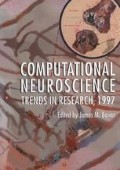Abstract
A simple mathematical model for the large-scale circuitry of primary visual cortex is introduced. It is shown that a basic cortical architecture of recurrent local excitation and lateral inhibition can account quantitatively for such properties as orientation tuning. Non-local coupling between similar orientation patches, when added to the model, can satisfactorily reproduce such effects as non-local iso-orientation suppression, and non-local cross-orientation enhancement. Following this an account is given of perceptual phenomena such as the direct and indirect tilt illusions.
Access this chapter
Tax calculation will be finalised at checkout
Purchases are for personal use only
Preview
Unable to display preview. Download preview PDF.
References
Blasdel, G.G., Orientation selectivity, preference, and continuity in monkey striate cortex, J. Neurosci. 12 No 8, 3139–3161 (1992).
Hubel, D.H. and Wiesel, T.N., Receptive fields, binocular interaction and functional architecture in the cat’s visual cortex. J. Physiol. Lond. 160, 106–154, (1962).
Victor, J.D., Purpura, K., Katz, E. and Mao. B., Population encoding of spatial frequency, orientation and color in macaque VI, J. Neurophysiol., 72 No 5, (1994).
Tsodyks, M.V. and Sejnowski, T.,Rapid state switching in balanced cortical network models, Network, 6 No 2, 111–124, (1995).
Vreeswijk, C. and Sompolinsky, H., Chaos in neuronal networks with balanced excitatory and inhibitory activity, Science 274, 1724–1726, (1996).
Fitzpatrick, D., The Functional Organization of Local Circuits in Visual Cortex: Insights from the Study of Tree Shrew Striate Cortex, Cerebral Cortex 6, 329–341, (1996).
Blakemore, C. and Tobin, E.A.,Lateral Inhibition Between Orientation Detectors in the Cat ‘s Visual Cortex, Exp. Brain Res., 15, 439–440, (1972).
Sillito, A.M., Grieve, K.L., Jones, H.E., Cudeiro, J. and Davis, J., Visual cortical mechanisms detecting focal orientation discontinuities, Nature, 378, 492–496, (1995).
Wenderoth, P. and Johnstone, S., The different mechanisms of the direct and indirect tilt illusions, Vision Res., 28 No 2, 301–312, (1988).
Wenderoth, P. and Beh, H.,Component analysis of orientation illusions, Perception, 6 57–75, (1977).
Carpenter, R.H.S. and Blakemore, C.,Interactions between orientations in human vision, Expl. Brain. Res., 18, 287–303, (1973).
Author information
Authors and Affiliations
Editor information
Editors and Affiliations
Rights and permissions
Copyright information
© 1997 Springer Science+Business Media New York
About this chapter
Cite this chapter
Mundel, T., Dimitrov, A., Cowan, J.D. (1997). A Simple Model for Cortical Orientation Selectivity. In: Bower, J.M. (eds) Computational Neuroscience. Springer, Boston, MA. https://doi.org/10.1007/978-1-4757-9800-5_67
Download citation
DOI: https://doi.org/10.1007/978-1-4757-9800-5_67
Publisher Name: Springer, Boston, MA
Print ISBN: 978-1-4757-9802-9
Online ISBN: 978-1-4757-9800-5
eBook Packages: Springer Book Archive

